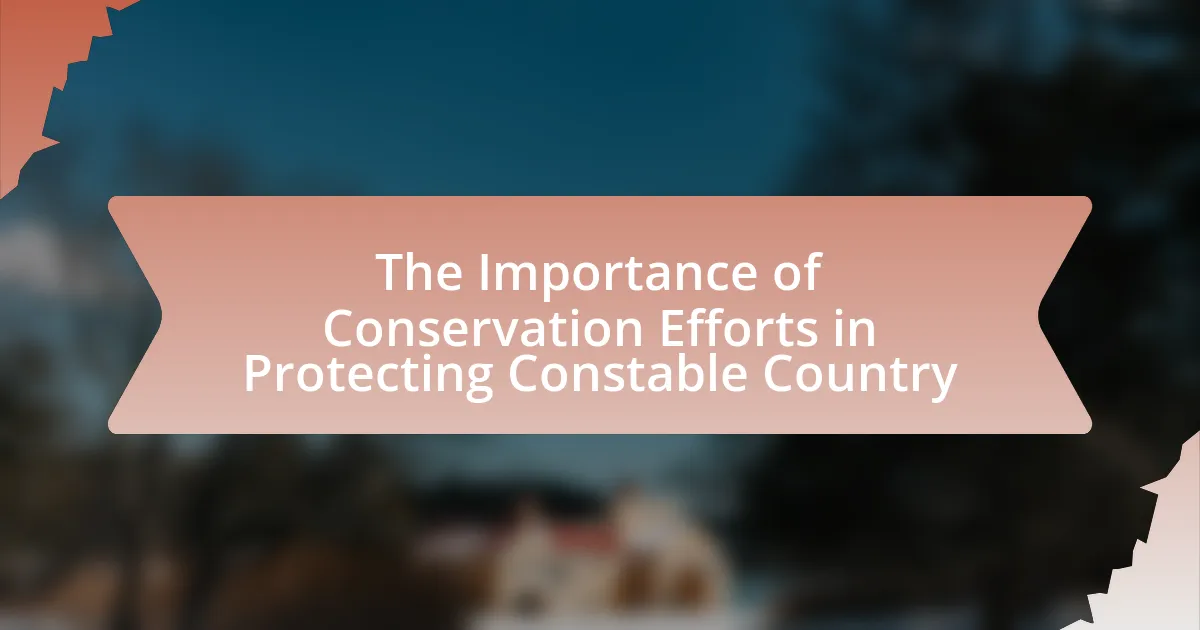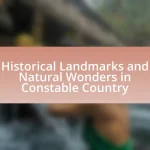Constable Country, a region renowned for its cultural and ecological significance, is the focus of key conservation efforts aimed at preserving its unique landscapes and biodiversity. These efforts include habitat restoration, sustainable land management, and community engagement initiatives, which collectively enhance local ecosystems and protect vulnerable species such as the Eurasian otter and water vole. The article explores the impact of these conservation strategies on biodiversity, the challenges posed by climate change and urban development, and the vital role of local communities in fostering stewardship and awareness. Additionally, it highlights successful community-led projects and practical steps individuals can take to contribute to the conservation of this historically rich area.
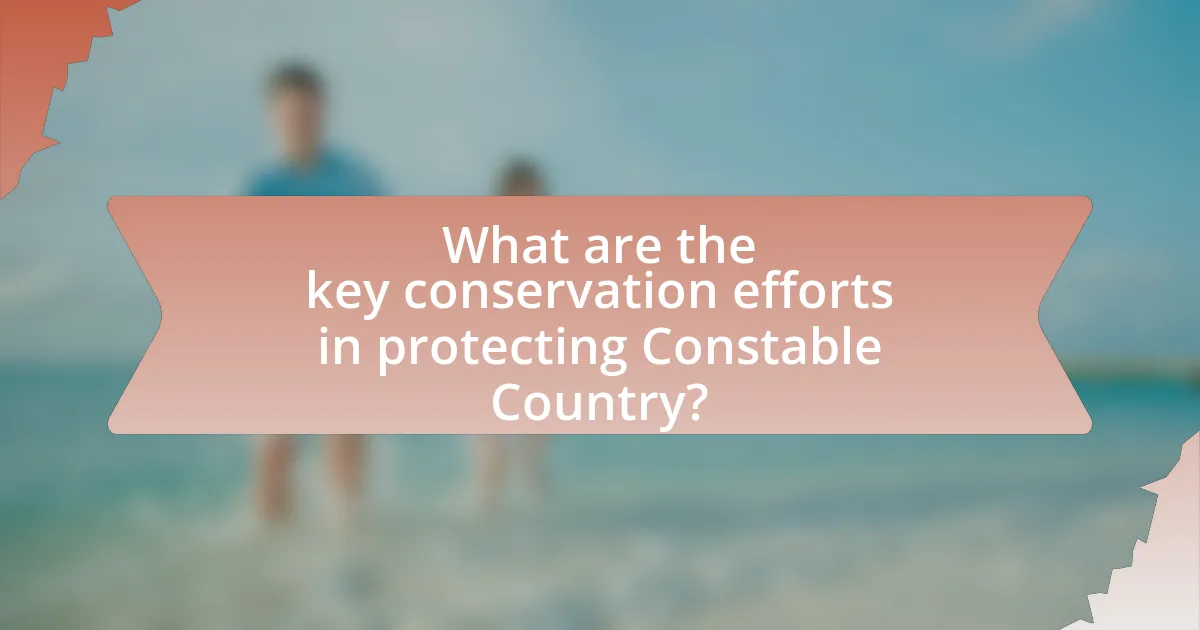
What are the key conservation efforts in protecting Constable Country?
Key conservation efforts in protecting Constable Country include habitat restoration, sustainable land management, and community engagement initiatives. Habitat restoration focuses on re-establishing native flora and fauna, which is crucial for maintaining biodiversity in the area. Sustainable land management practices are implemented to balance agricultural activities with ecological preservation, ensuring that farming does not degrade the landscape. Community engagement initiatives involve local residents in conservation activities, fostering a sense of stewardship and awareness about the importance of preserving this culturally and ecologically significant region. These efforts are supported by organizations such as the National Trust and local conservation groups, which provide resources and expertise to enhance the effectiveness of these initiatives.
How do these conservation efforts impact the local ecosystem?
Conservation efforts significantly enhance the local ecosystem by restoring habitats and increasing biodiversity. These initiatives, such as reforestation and wetland restoration, provide critical resources for native species, leading to healthier populations and improved ecological balance. For instance, studies have shown that areas undergoing active conservation can see a 30% increase in species richness within five years, demonstrating the direct positive effects of these efforts on local wildlife and plant communities.
What specific species are being protected through these efforts?
The specific species being protected through conservation efforts in Constable Country include the Eurasian otter, the water vole, and various species of birds such as the barn owl and the skylark. These species are targeted due to their ecological significance and vulnerability to habitat loss. For instance, the Eurasian otter is a key indicator of healthy aquatic ecosystems, while the water vole is critically endangered in the UK, with populations declining by over 90% since the 1970s. Conservation initiatives aim to restore habitats and promote biodiversity, ensuring the survival of these species in their natural environment.
How do conservation efforts contribute to biodiversity in Constable Country?
Conservation efforts significantly enhance biodiversity in Constable Country by protecting habitats and promoting species recovery. These initiatives, such as habitat restoration and the establishment of protected areas, create safe environments for various flora and fauna, allowing populations to thrive. For instance, the reintroduction of native species and the control of invasive species have been shown to restore ecological balance, which is crucial for maintaining diverse ecosystems. Additionally, community engagement in conservation activities fosters awareness and support for biodiversity, leading to sustainable practices that further benefit the region’s natural heritage.
Why is conservation important for the cultural heritage of Constable Country?
Conservation is crucial for the cultural heritage of Constable Country because it preserves the landscapes and historical sites that inspired the renowned painter John Constable. These areas, characterized by their natural beauty and historical significance, are integral to understanding the artistic and cultural legacy of the region. Protecting this heritage ensures that future generations can appreciate and learn from the unique environmental and cultural narratives that define Constable Country, which has been recognized for its artistic value since the 19th century.
What historical significance does Constable Country hold?
Constable Country holds historical significance as the inspiration for many of John Constable’s iconic landscape paintings, which reflect the rural life and natural beauty of the Suffolk countryside in the early 19th century. This region, particularly around Dedham Vale, showcases the picturesque qualities that Constable sought to capture, influencing the Romantic movement in art. The area’s preservation as a designated Area of Outstanding Natural Beauty (AONB) since 1965 further emphasizes its cultural and historical value, ensuring that the landscapes that inspired Constable remain protected for future generations.
How do conservation efforts preserve the cultural landscape?
Conservation efforts preserve the cultural landscape by implementing strategies that protect historical sites, traditional practices, and natural resources integral to cultural identity. These efforts often involve the restoration of landscapes to their historical conditions, safeguarding architectural heritage, and promoting sustainable land use practices that respect local customs. For instance, in Constable Country, initiatives such as the designation of protected areas and the promotion of local agricultural practices help maintain the visual and cultural integrity of the region, ensuring that the landscape reflects its historical significance and supports community identity.
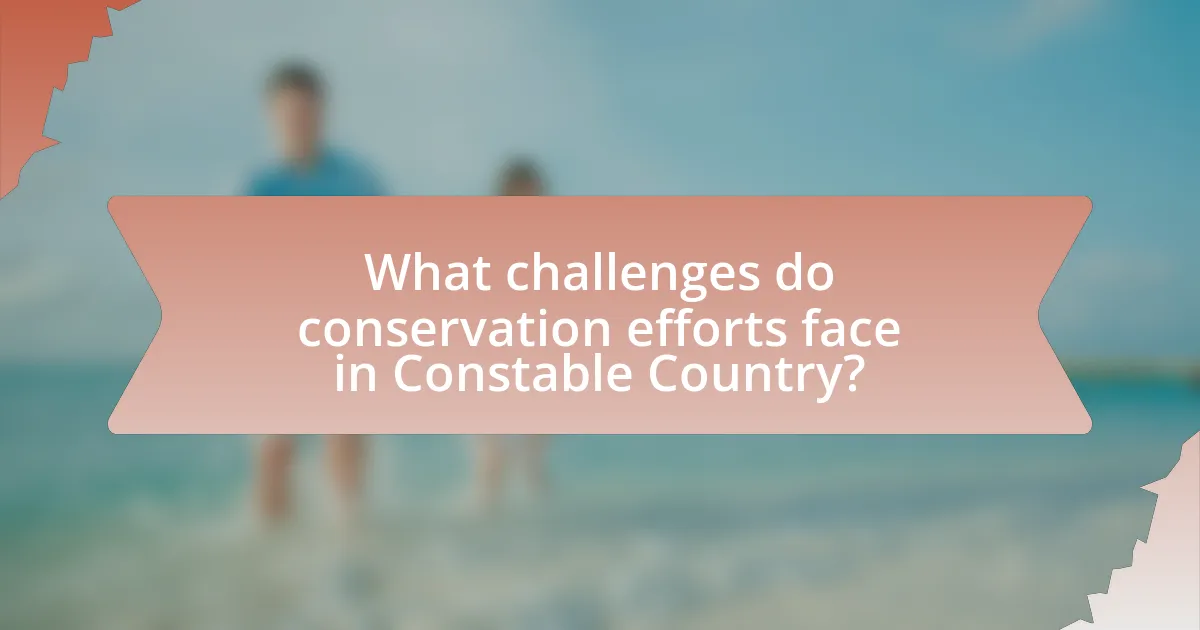
What challenges do conservation efforts face in Constable Country?
Conservation efforts in Constable Country face challenges such as habitat degradation, invasive species, and climate change. Habitat degradation results from agricultural practices and urban development, which threaten local ecosystems. Invasive species disrupt native flora and fauna, leading to biodiversity loss. Climate change exacerbates these issues by altering weather patterns and affecting species survival. These challenges hinder effective conservation strategies and require targeted interventions to protect the unique landscape and biodiversity of Constable Country.
How do climate change and human activity threaten conservation efforts?
Climate change and human activity significantly threaten conservation efforts by altering ecosystems and increasing habitat destruction. Rising temperatures, shifting precipitation patterns, and extreme weather events disrupt the natural habitats of various species, leading to biodiversity loss. For instance, a study published in the journal “Nature” found that climate change could push one in six species to extinction by 2100 if current trends continue. Additionally, human activities such as deforestation, urbanization, and pollution further degrade habitats, making it difficult for wildlife to adapt to changing conditions. The combination of these factors undermines the effectiveness of conservation strategies aimed at protecting vulnerable species and ecosystems.
What specific impacts does climate change have on Constable Country’s environment?
Climate change significantly impacts Constable Country’s environment by altering weather patterns, increasing flooding, and threatening biodiversity. Rising temperatures lead to more frequent and intense rainfall, which can cause soil erosion and habitat destruction. Additionally, changing climatic conditions disrupt local ecosystems, putting pressure on native species and increasing the risk of invasive species taking hold. For instance, studies indicate that the frequency of extreme weather events in the region has risen, affecting both flora and fauna. These changes necessitate urgent conservation efforts to mitigate the adverse effects on this historically rich landscape.
How does urban development affect conservation initiatives?
Urban development negatively impacts conservation initiatives by increasing habitat destruction and fragmentation. As cities expand, natural habitats are often converted into residential, commercial, or industrial areas, leading to a loss of biodiversity. For instance, a study published in the journal “Ecological Applications” found that urbanization can reduce species richness by up to 75% in affected areas. Additionally, urban development often introduces pollution and invasive species, further threatening local ecosystems. These factors collectively hinder conservation efforts aimed at preserving natural landscapes and wildlife in regions like Constable Country.
What role do local communities play in conservation efforts?
Local communities play a crucial role in conservation efforts by actively participating in the management and protection of their natural resources. Their involvement often leads to more effective conservation strategies, as local knowledge and practices are integrated into formal conservation plans. For instance, studies have shown that community-led initiatives can enhance biodiversity and improve ecosystem health, as seen in various successful projects worldwide, such as the community-based conservation efforts in Costa Rica, which resulted in a significant increase in forest cover and wildlife populations.
How can community engagement enhance conservation outcomes?
Community engagement enhances conservation outcomes by fostering local stewardship and increasing public awareness of environmental issues. When communities actively participate in conservation efforts, they develop a sense of ownership and responsibility towards their natural resources, leading to more sustainable practices. Research indicates that areas with strong community involvement in conservation initiatives, such as the Great Barrier Reef Marine Park, have seen improved biodiversity and habitat restoration outcomes. Engaged communities are more likely to support and adhere to conservation policies, resulting in effective long-term environmental management.
What are some successful community-led conservation projects in Constable Country?
Successful community-led conservation projects in Constable Country include the Dedham Vale AONB (Area of Outstanding Natural Beauty) initiative, which focuses on habitat restoration and sustainable land management. This project has engaged local residents in activities such as tree planting, wildlife monitoring, and educational workshops, fostering a sense of stewardship among the community. Additionally, the “Constable Country Landscape Partnership” has successfully implemented projects aimed at preserving the cultural and natural heritage of the area, including the restoration of historic landscapes and promotion of biodiversity. These initiatives demonstrate the effectiveness of community involvement in conservation efforts, contributing to the protection and enhancement of Constable Country’s unique environment.
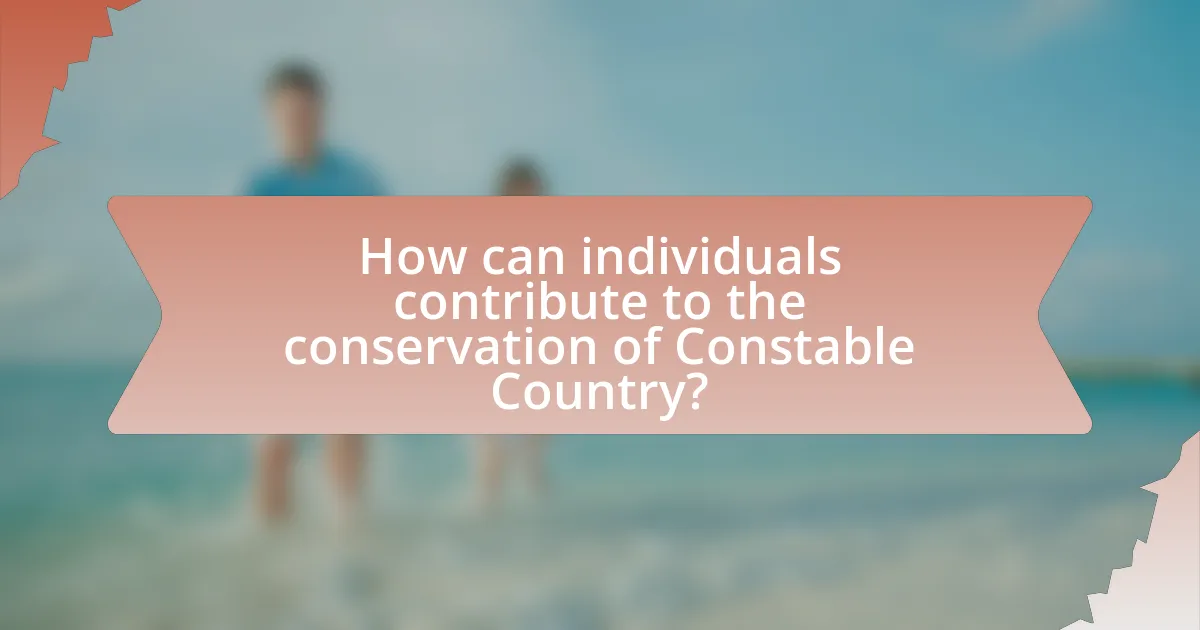
How can individuals contribute to the conservation of Constable Country?
Individuals can contribute to the conservation of Constable Country by participating in local conservation initiatives, such as volunteering for habitat restoration projects and supporting wildlife protection efforts. Engaging in activities like tree planting, litter clean-ups, and monitoring local wildlife populations directly aids in preserving the area’s natural beauty and biodiversity. Additionally, individuals can advocate for sustainable tourism practices and educate others about the importance of protecting this unique landscape, which has been recognized for its cultural and ecological significance. By actively participating in these efforts, individuals help maintain the integrity of Constable Country for future generations.
What practical steps can individuals take to support conservation efforts?
Individuals can support conservation efforts by participating in local clean-up initiatives, which directly reduce pollution and protect natural habitats. Engaging in activities such as beach clean-ups or park restoration projects helps maintain the ecological balance and promotes biodiversity. Additionally, individuals can reduce their carbon footprint by using public transportation, cycling, or walking, which contributes to lower greenhouse gas emissions. Supporting sustainable products and local businesses also fosters conservation, as it encourages environmentally friendly practices. Furthermore, volunteering with conservation organizations or donating to wildlife protection funds amplifies the impact of individual efforts. According to the World Wildlife Fund, community involvement in conservation projects has been shown to enhance local ecosystems and promote sustainable practices.
How can volunteering impact conservation initiatives?
Volunteering can significantly enhance conservation initiatives by providing essential manpower and resources needed for various projects. Volunteers contribute to habitat restoration, species monitoring, and community education, which are critical for the success of conservation efforts. For instance, a study by the National Park Service found that volunteer programs in national parks led to a 20% increase in the completion of conservation projects, demonstrating the tangible benefits of volunteer involvement. Additionally, volunteers often raise awareness and foster community engagement, which can lead to increased funding and support for conservation initiatives.
What are the benefits of participating in local conservation programs?
Participating in local conservation programs offers numerous benefits, including the enhancement of biodiversity and the protection of natural habitats. These programs actively engage community members in preserving local ecosystems, which leads to improved environmental health and resilience. For instance, studies have shown that areas involved in conservation efforts experience a 30% increase in native species populations over five years, demonstrating the effectiveness of community involvement in ecological restoration. Additionally, participants often gain valuable skills and knowledge about sustainable practices, fostering a deeper connection to their environment and promoting stewardship.
What resources are available for those interested in conservation in Constable Country?
Resources available for those interested in conservation in Constable Country include local conservation organizations, educational programs, and volunteer opportunities. Organizations such as the National Trust and the Suffolk Wildlife Trust actively engage in conservation efforts, providing information on local wildlife, habitats, and ongoing projects. Educational programs often include workshops and guided walks that focus on the area’s unique ecosystems and conservation challenges. Additionally, volunteer opportunities allow individuals to participate in hands-on conservation work, contributing to habitat restoration and species monitoring, thereby fostering community involvement in preserving Constable Country’s natural heritage.
Where can individuals find information on conservation organizations?
Individuals can find information on conservation organizations through various online platforms, including official websites, social media pages, and dedicated environmental databases. Websites such as the World Wildlife Fund, The Nature Conservancy, and local government environmental agencies provide comprehensive resources about conservation efforts, initiatives, and volunteer opportunities. Additionally, platforms like GuideStar and Charity Navigator offer insights into the effectiveness and financial health of various conservation organizations, helping individuals make informed decisions about their involvement.
What educational programs are available to raise awareness about conservation?
Educational programs available to raise awareness about conservation include school-based curricula, community workshops, and online courses. These programs often focus on local ecosystems, biodiversity, and sustainable practices, aiming to engage participants through hands-on activities and interactive learning. For instance, the National Wildlife Federation offers educational resources that emphasize wildlife conservation and habitat protection, while organizations like the World Wildlife Fund provide online courses that cover global conservation issues. Such programs have been shown to increase knowledge and foster a sense of responsibility towards environmental stewardship, as evidenced by studies indicating that participants in conservation education programs demonstrate improved attitudes and behaviors regarding environmental issues.
